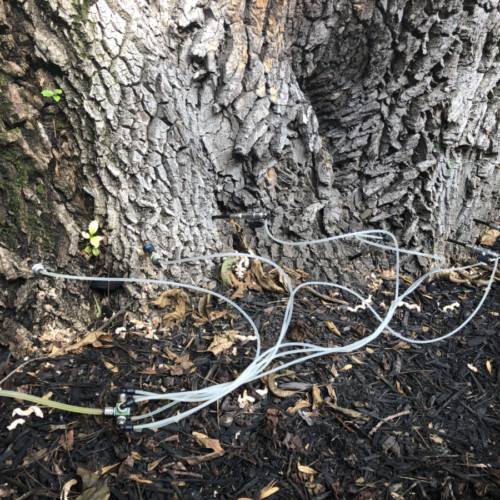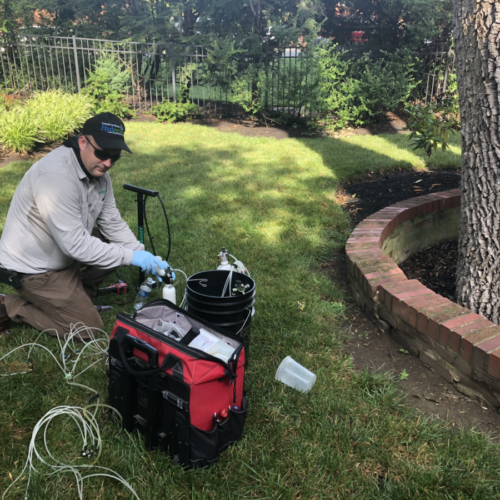Abigail the Green Ash in Alexandria
July 30, 2020 10:42 am
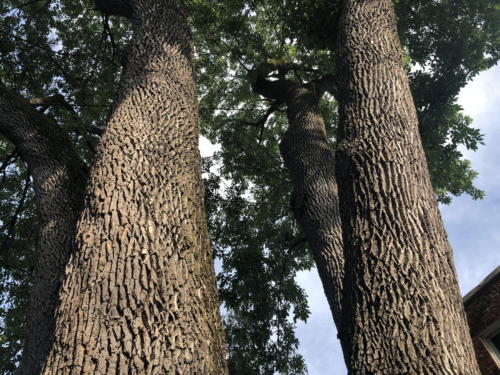
On July 22, VDOF’s urban & community forestry (U&CF) manager Lara Johnson traveled to Alexandria, Virginia to visit a well-known green ash tree. This ash, located in a courtyard between two apartment buildings, is likely hundreds of years old and is one of largest ash trees in the nation.
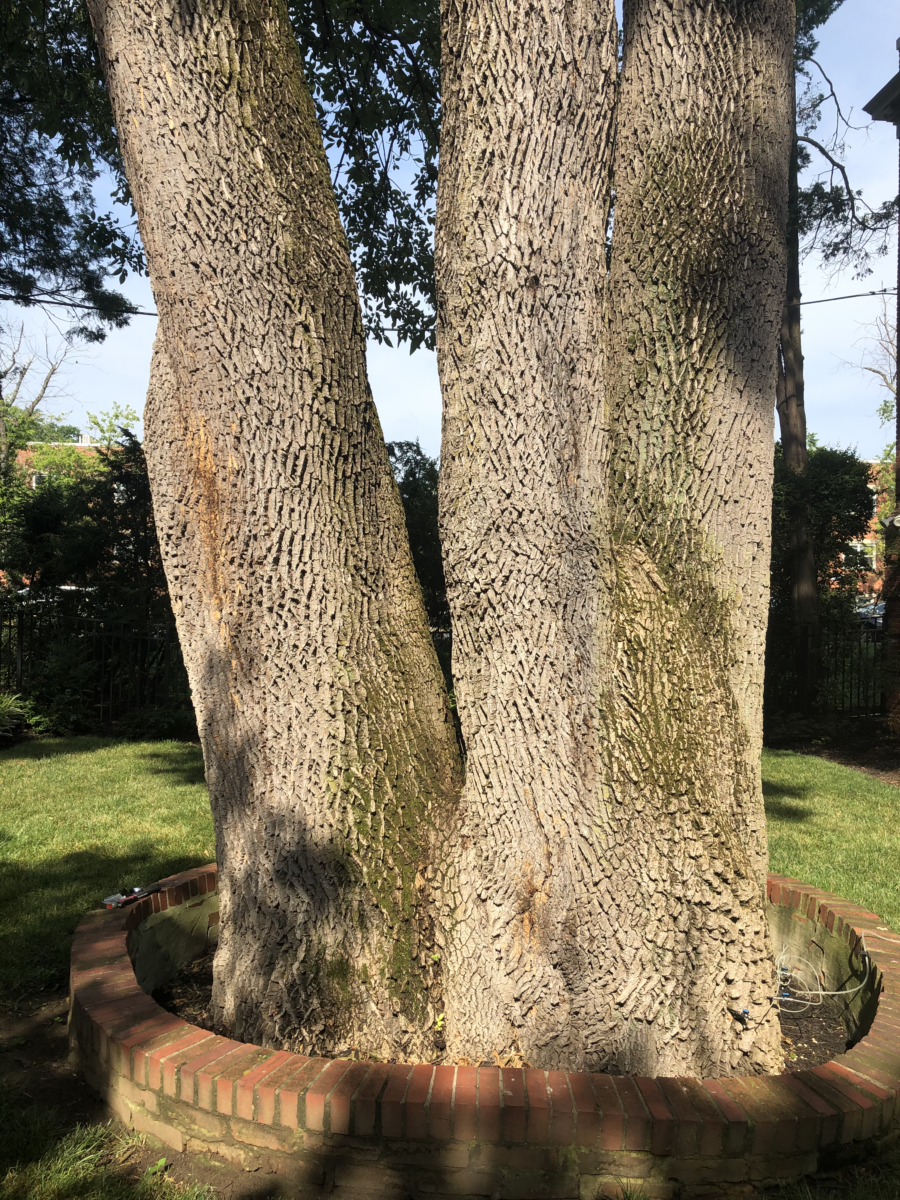
Abigail’s trunks (right and left) each had a circumference of 12’ 9” and 11’ 6” respectively. The tree’s base measured 21’.
Abigail (so named by property managers Mike and Olivia) is the current Virginia State Champion and was once the National Big Tree Champion in the ash category (dethroned only because of qualification adjustments for multi-stemmed trees).
During this visit, Lara was able to remeasure the tree with the assistance of Andrew Benjamin, an arborist with the City of Alexandria. Abigail’s trunks (right and left, as in the photo) each had a circumference of 12’ 9” and 11’ 6” respectively. The tree’s base measured 21’. Lara will report these measurements, along with the tree’s height (78’ 6”) and crown spread, to the Big Tree program.
Protecting Ash
But remeasuring Abigail was not the primary reason for the visit. Lara was there to support the tree’s on-going treatment against emerald ash borer (EAB) – an invasive pest threatening ash trees across the state and beyond. Insecticidal treatment can protect individual trees from the damage and eventual death caused by EAB.
The City of Alexandria had been providing treatment for the tree, but in recent years VDOF was able to offer financial support toward trunk injection treatment of this tree through a grant program developed to protect ash. Using this funding, Lara and Fairfax County staff first treated the Champion tree in 2018. But such funding is limited, and the chemicals and labor required to perform treatment can be costly for landowners, particularly for large trees like this ash.

Abigail the green ash tree & the 2018 EAB treatment team.
Fortunately, plant health company Arborjet offered to take over treatment of this historic ash tree. Through their “Saving America’s Iconic Trees” program, Arborjet donates treatment against pests and disease for high-profile, iconic trees, like this ash, across the country. Community leaders and homeowners can nominate iconic trees for potential inclusion in the program. These treatments with an Arborjet technician serve as educational opportunities and are open for other professionals to observe.
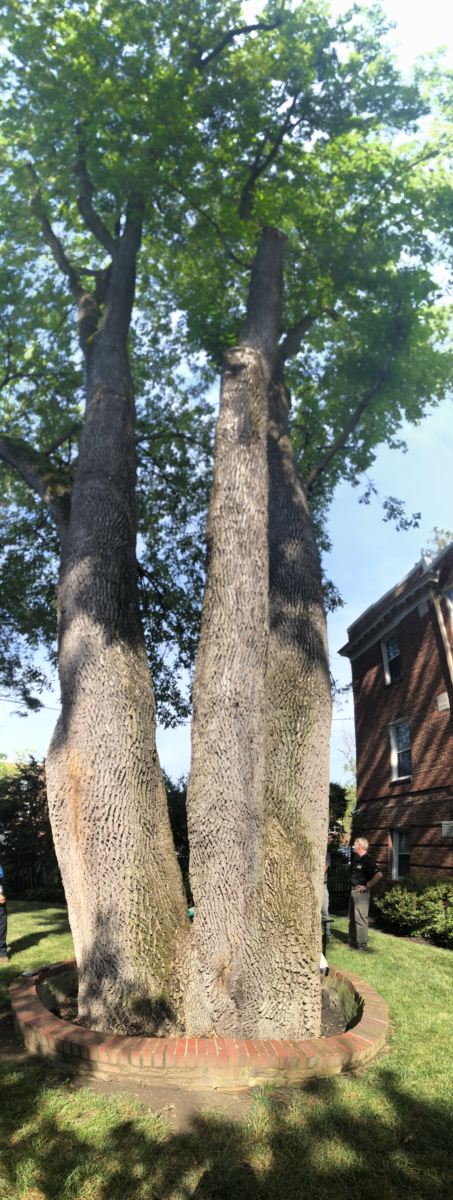
A panoramic view of Abigail. To the right in the photo is local arborist Mike Cochran, on-site to observe the application of the injection system and chemical for potential use in his own operation.
Arborjet’s Eastern Technical Manager and International Society of Arboriculture-certified arborist Trent Dicks was on-site to perform the treatment with Lara’s support. Treatment began early in the morning to increase effectiveness. Both Lara and Trent agreed that the high temperatures that Virginia has recently experienced could make treatment challenging because it relies on transpiration – the tree drawing up water (and the chemicals) through the roots into the phloem.
Trent first measured the tree to determine how much chemical was needed for treatment. Then, a series of 34 holes were drilled into the tree’s base as close to the root flare as possible. This presented a challenge, as the tree is below grade and surrounded by a small retaining wall and has very thick “alligator bark” which can be difficult to penetrate.
A plug was placed in each hole, into which a needle would be inserted and pressurized tubes pump insecticide into the tree. The plugs remain in place and a healthy tree readily heals over them.
The duo finished the work quickly as temperatures rose. After less than two hours, treatment and measurements were complete and the small crowd that had formed to observe had dispersed.
Historic Trees
While almost any ash tree in the landscape has potential to be a good candidate, it is the large, historic and rare ash specimens that are often prioritized for on-going treatment because costs can be high.
Did you know?: Green ash trees are a riparian species, and this historic tree is indicative of the relic wetland landscape that once covered northern Virginia.
Abigail is a beloved tree on a “charming, historic property” says property manager Olivia. In the 1940s, the buildings were essentially built around the tree, which serves as a centerpiece in the courtyard and provides shade for residents enjoying time on the patio. “It’s remarkable that this tree survived construction of the buildings. Normally that activity would damage a tree’s root system, but this tree was obviously well-established and the roots were able to recover,” says Lara.
Olivia and Mike explained that they frequently have to clean out the gutters because Abigail’s canopy extends over the roof, and although a bit “high maintenance”, the ash tree is well worth the effort.
Abigail receives other care (such as pruning) from arborists during the year, and although there were historically some signs of EAB impacts (i.e. dead wood), the tree has healed nicely since the 2018 treatment. Thanks to treatment and continued care from certified arborists, there’s hope this tree will stand tall in the neighborhood for many years to come!
Tags: Arborists, Ash, Heritage, Partnerships, Roots, Urban Forestry
Category: Urban and Community Forestry

